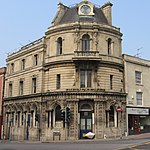Kingsley Hall, Bristol
1706 establishments in EnglandBristol building and structure stubsGeorgian architecture in BristolGrade II* listed buildings in BristolHouses completed in 1706 ... and 3 more
Houses in BristolIndependent Labour PartyUse British English from February 2023

Kingsley Hall (grid reference ST596731) is at 59 Old Market Street in Old Market, Bristol. The hall was built as a private house in 1706 and restored in the late 19th century for use as a political club and office premises. It was originally occupied by the East Bristol Conservative Party. In 1911, it became the Bristol headquarters of the Independent Labour Party who renamed it in honour of the Christian Socialist Charles Kingsley. It is now used as offices by 1625 Independent People, a charity housing young people.It has been designated by English Heritage as a grade II* listed building.
Excerpt from the Wikipedia article Kingsley Hall, Bristol (License: CC BY-SA 3.0, Authors, Images).Kingsley Hall, Bristol
Old Market Street, Bristol St Philip's
Geographical coordinates (GPS) Address External links Nearby Places Show on map
Geographical coordinates (GPS)
| Latitude | Longitude |
|---|---|
| N 51.455919 ° | E -2.581369 ° |
Address
1625 Independent People
Old Market Street 59
BS2 0ER Bristol, St Philip's
England, United Kingdom
Open on Google Maps








